Beth Kephart's Blog, page 68
October 15, 2014
The Schuylkill River Trail, in Pottstown
 Last evening, the sun setting, I sat by the river trail in Pottstown. No paper in hand. No book. No pen. Just sat and watched the sun change the color of the trees, the ducks disturb the water, the cyclists stream by in fluorescent shirts.
Last evening, the sun setting, I sat by the river trail in Pottstown. No paper in hand. No book. No pen. Just sat and watched the sun change the color of the trees, the ducks disturb the water, the cyclists stream by in fluorescent shirts.Later I walked down the road to Montgomery Community College West and spoke of river history and river dreams with those who know the river best—trail blazers, volunteers, bikers, historians, people with stories to tell about Abraham Lincoln and Thomas Jefferson, teachers, artists, a minister, a former physician who has brought his exacting eye to river trails and maps.
It takes a village to rescue rivers. What river rescuers we're blessed with.
With thanks to Kurt Zwikl and Laura Catalano of the Schuylkill River Heritage Area, who created the evening. With thanks to everyone who came—such warmth, such very good questions. And looking forward to Thursday evening, when I travel to the city to meet with another cadre of river souls as part of our celebration of the river.
Anyone who loves our river is welcome. Join us.




Published on October 15, 2014 05:29
October 14, 2014
River Dreams: tonight is the night (and so is Thursday)
 We invite you to our celebration of the Schuylkill River, 2014 Pennsylvania River of the Year. This evening I'll be at Montgomery County Community College West Campus, in the Community Room in South Hall at 7 p.m. A second presentation will be held on Thursday Oct. 16 at 7 p.m. at the Trinity Center for Urban Life in Philadelphia. Both events are free.
We invite you to our celebration of the Schuylkill River, 2014 Pennsylvania River of the Year. This evening I'll be at Montgomery County Community College West Campus, in the Community Room in South Hall at 7 p.m. A second presentation will be held on Thursday Oct. 16 at 7 p.m. at the Trinity Center for Urban Life in Philadelphia. Both events are free.I'm deeply grateful to the good people at Schuylkill River Heritage Area, Fairmount Water Waters, Schuylkill Banks, and Temple University Press, who have so generously spread the word. My talk, titled "River Dreams: History, Hope, and the Imagination," begins like this:
<!-- /* Font Definitions */ @font-face {font-family:Cambria; panose-1:2 4 5 3 5 4 6 3 2 4; mso-font-charset:0; mso-generic-font-family:auto; mso-font-pitch:variable; mso-font-signature:3 0 0 0 1 0;} /* Style Definitions */ p.MsoNormal, li.MsoNormal, div.MsoNormal {mso-style-parent:""; margin:0in; margin-bottom:.0001pt; mso-pagination:widow-orphan; font-size:12.0pt; mso-bidi-font-size:10.0pt; font-family:"Times New Roman"; mso-ascii-font-family:Cambria; mso-ascii-theme-font:minor-latin; mso-fareast-font-family:Cambria; mso-fareast-theme-font:minor-latin; mso-hansi-font-family:Cambria; mso-hansi-theme-font:minor-latin; mso-bidi-font-family:"Times New Roman"; mso-bidi-theme-font:minor-bidi;} @page Section1 {size:8.5in 11.0in; margin:1.0in 1.25in 1.0in 1.25in; mso-header-margin:.5in; mso-footer-margin:.5in; mso-paper-source:0;} div.Section1 {page:Section1;} </style> --> <blockquote class="tr_bq"><div class="MsoNormal"><span style="font-size: 16.0pt; mso-bidi-font-size: 10.0pt;">Neither oil nor borders. Not religion. Not historical hurts or misremembered sleights. None of these. The next world wars, the experts say, will be fought over water. Over the three percent of the earth’s liquid total that pools in ponds and lakes, careens down channels, overruns crevasses, oozes from retreating glaciers, is barricaded up inside man-made reservoirs, is yanked up from the bottom of the well, is carried, jug to jug and bottle to hand toward cupped palms. Seeds, omnivores, carnivores, herbivores, feathered things—they need it. So do the pink dolphins and the mighty mollusks and the bulge-eyed toads and the little girl with the cascade of curls who has come to the banks with her heart set on adventure.</span></div></blockquote><br />More can be found <a href="http://beth-kephart.blogspot.com/2014.... <div class="feedflare">
<a href="http://feeds.feedburner.com/~ff/BethK... src="http://feeds.feedburner.com/~ff/BethK..." border="0"></img></a> <a href="http://feeds.feedburner.com/~ff/BethK... src="http://feeds.feedburner.com/~ff/BethK..." border="0"></img></a> <a href="http://feeds.feedburner.com/~ff/BethK... src="http://feeds.feedburner.com/~ff/BethK..." border="0"></img></a> <a href="http://feeds.feedburner.com/~ff/BethK... src="http://feeds.feedburner.com/~ff/BethK..." border="0"></img></a>
</div>
Published on October 14, 2014 06:47
On metaphor: "Thinking is a kind of simulated interaction with the world"
 From I Is An Other: The Secret Life of Metaphor and How it Shapes the Way We See the World, by James Geary
From I Is An Other: The Secret Life of Metaphor and How it Shapes the Way We See the World, by James GearyThe upshot of all this research is: thinking is a kind of simulated interaction with the world, a metaphorical engagement that makes what we imagine more realistic. Mental images can have the same effect on the body and the mind as actual physical things. And metaphors are mental image makers par excellence.... Metaphors are experience's body doubles, standing in for actual objects and events.




Published on October 14, 2014 04:49
October 13, 2014
My Mistake/Daniel Menaker: Reflections
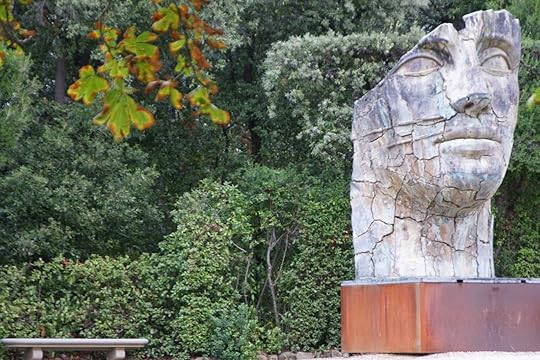 Daniel Menaker's memoir My Mistake fills me with a desire for confession.
Daniel Menaker's memoir My Mistake fills me with a desire for confession.I'll keep this unnaturally brief: Once, aged twenty-five, attempting to strike out on my own as a writing consultant, I misspelled the word "renown" in my proposal. I did not get the job. Once, after the publication of one of those Kephart memoirs, I discovered a mistake or maybe even two; I barely left the house for the next three months, afraid that any perceived movement on my part would lead to the discovery of my crime. Once, dead tired after a transatlantic flight, I picked up the wrong suitcase from the Heathrow carousel (see, even here, I am giving myself an excuse). Once, a few posts ago, on this very blog, I misspelled the last name of Eula Biss. I have been wrong and failed to apologize. I have apologized for mistakes I never made, also typically a mistake, for the gesture rarely silences the accuser. I have forgotten the lady's name at church. I have intuited incorrectly. I have supposed and I have suspected. I have given bad advice. I have been impatient. I fell on the double axle in my last skating competition while floating to a West Side Story number.
My Mistake. Singular. What a brilliant title for a brilliant book by a former fact checker and fiction editor for The New Yorker, former Random House executive editor in chief (he worked with Colum McCann, people), and still and always author. I have dog-earred one thousand of its 234 pages. I have felt a certain bliss just sitting and reading this personal and publishing history, gossip and innuendo. These stories about William Maxwell and Michael Cunningham, Alice Munro and Tina Brown, Anonymous and an MRI nurse with a ripe sense of humor. These explications of New Yorker style. These truths about the a death of a brother, the terror of anxiety, the budding of a new spring.
My Mistake is musical and funny, heartbreaking and consoling. It is insanely readable. It is the sort of thing I would have read aloud, except that I was on the SEPTA Quiet Car while turning many of its pages, and the rules were being strictly enforced.
Let me read out loud, then, on this blog.
On the cult of The New Yorker:
However consciously or un-, The New Yorker, a kind of Jonestown of the literary/journalistic realm, encourages in its employees an ethos of superiority, essentialness, and disregard for fad and fashion. Shawn himself, in his words and demeanor, appears to disavow any self-importance. He wants to be taken as a quiet, modest man who puts the greatness of the institution he runs above all else. This faux-modest version of occupational vanity, in combination with native timidity, keeps very intelligent people in the same, often dead-end, jobs for years, simply because they can say, in this modestly quiet voice, that they work for The New Yorker. Great institutions, so long as they are small, will often (a) eventually take themselves too seriously and (b) try to camouflage their pride with self-effacement.On panic, a condition with which I am much too intimately familiar:
But for pity's sake don't dismiss this affliction as a chimera or a ruse or a plea for attention or any of the other at least implicitly condemnatory assessments that so many so often make of it. It is all too real, itself and nothing else, and it can be disabling. It came close to disabling me for life. The prospect of lunch with a colleague was torture. Flying was a sentence. Social life an ordeal. It's no wonder that with Valium always on my person and the need to lose myself in something that would take my mind off this dread, I throw my energy into fact-checking so violently. I start psychoanalysis and keep the Valium in the shirt pocket over my heart. This goes on, gradually abating, for many years.On publishing:
It's my strong impression that most of the really profitable books for most publishers still come from the mid-list—"surprise" big hits bought with small or medium advances, such as that memoir by a self-described racial "mutt" of a junior senator from Chicago. Somehow, by luck or word of mouth, these books navigate around the rocks and reefs upon which most of their fleet—even sturdy vessels—founder. This is an old story but one that media giants have not yet heard, or at least not heeded, or so it seems.Okay, obviously, I am a fan. Such a fan that I decided, mid-course or maybe sooner, to assign My Mistake to my Penn students in the spring. I can't think of a more complete introduction to life and forgiveness, facts and foibles, literary thinking.




Published on October 13, 2014 14:44
New York City skyline, the week ahead, and Menaker's "My Mistake"
 It was a weekend of many friends and many faces. Talking memoir, then book marketing at the annual Push to Publish conference. Performing a "Blurred Lines" cha-cha with my husband at the gorgeous Goodhart Hall on the Bryn Mawr College campus (we're still standing). Setting off for a perfect Sunday with our son, a day that ended with this glimpse of New York City magic.
It was a weekend of many friends and many faces. Talking memoir, then book marketing at the annual Push to Publish conference. Performing a "Blurred Lines" cha-cha with my husband at the gorgeous Goodhart Hall on the Bryn Mawr College campus (we're still standing). Setting off for a perfect Sunday with our son, a day that ended with this glimpse of New York City magic.In the week ahead I'll be at Montgomery County Community College (Tuesday evening) and at Trinity Center for Urban Life (Thursday evening) to give a talk I've titled "RIVER DREAMS: History, Hope and the Imagination," a keynote on behalf of the Schuylkill River's designation as the 2014 Pennsylvania River of the Year. The events are free and open to the public, and we hope you'll consider joining us. More information can be found here.
I also hope to be able to finish reading (and subsequently blogging) Daniel Menaker's My Mistake, a terrific memoir about the life of this former editor. We make mistakes (I've not yet met a perfect person). Some deeply change the course of our lives, or the lives of others. Some are cheek-blushing, oh-damn foibles from which we learn. Menaker's book (I'm halfway through) yields, above all else, perspective. I look forward to sharing more of it here in days to come.




Published on October 13, 2014 04:03
October 12, 2014
On what one Mural Arts installation helped me see, in today's Inquirer
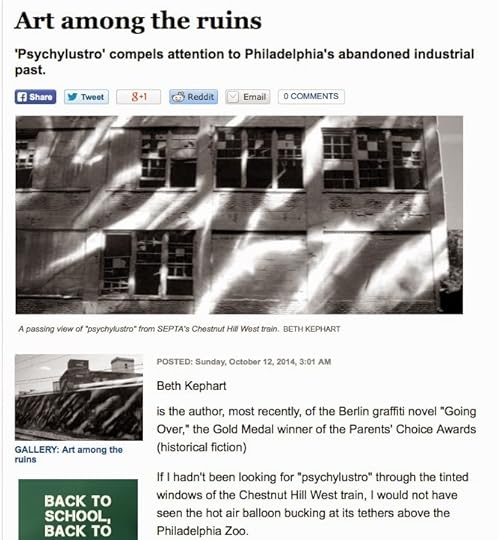 Today, in the Philadelphia Inquirer, some thoughts about "Psychylustro," the Mural Arts installation that has redefined how SEPTA and AMTRAK passengers see—and perhaps think about—Philadelphia's industrial past.
Today, in the Philadelphia Inquirer, some thoughts about "Psychylustro," the Mural Arts installation that has redefined how SEPTA and AMTRAK passengers see—and perhaps think about—Philadelphia's industrial past.The entire story can be found here.




Published on October 12, 2014 04:38
October 11, 2014
less than solitary: reconnecting with an old friend for a new project
 Years ago, when I was young—wait. Was I ever young? Not that I can remember. I'll start again.
Years ago, when I was young—wait. Was I ever young? Not that I can remember. I'll start again.Reboot:
Books ago, I had the pleasure of working on a corporate fairy tale with my friend Matt Emmens, a book we called Zenobia: The Curious Book of Business. Zenobia, an Alice in Wonderland-like adventure through a dying (but then rejuvenated) corporation, ended up selling to a dozen foreign publishers. It broadened my collaboration with my husband, who created the book's fabulous illustrations. And it deepened my friendship with Matt, who had CEO'd many of the companies I've worked for through the years, but who I respect even more for his many passions and pursuits.
This past week, I had an excuse to again spend time talking with Matt as I continued work on a strange and percolating project. I asked Matt questions, and he summoned details. I asked for the sound of talk, and he recreated conversations. I sent him the chapter his knowledge had helped me write, and he sent back notes. You should consider. Drop the octagon. That would singular, not plural. If you're considering a night scene, consider this.
There's a lot of just plain hardship that goes along with writing. There's a lot of solitary. But when there's the chance to ask questions, go ask the questions. Your book will be better off. And so will you.
Speaking of less than solitary, in a few hours I'll be at Rosemont College for the annual Philadelphia Stories Push to Publish conference. First up for me (1:15), a memoir/nonfiction panel with my long-time friend Karen Rile and Anne Kaier. Second up (2:30), a marketing for published authors panel with another dear friend (Kelly Simmons) and Donna Galanti. From there, I'm rushing back home for a quick change and a nervous drive to a local stage, where I'll be dancing the cha cha with my husband.
I'm sleeping in tomorrow morning. Then I'll get up and work with a few new details dear Mr. Emmens just sent me.




Published on October 11, 2014 05:14
October 10, 2014
On Immunity by Eula Biss, in the Chicago Tribune
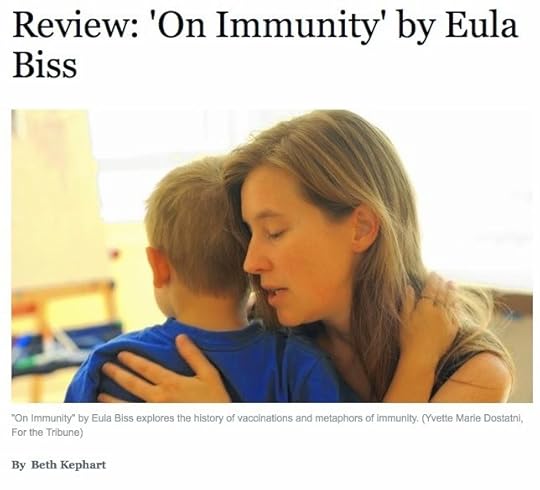 Earlier this week I spoke of Eula Biss's first book, The Balloonists, and how it made me think. This weekend, in the Chicago Tribune, I'm reflecting on Biss's new book, On Immunity, a book that has been generating much press for its artful exploration of the social ramifications of personal health decisions. My review begins like this, below, and continues here.
Earlier this week I spoke of Eula Biss's first book, The Balloonists, and how it made me think. This weekend, in the Chicago Tribune, I'm reflecting on Biss's new book, On Immunity, a book that has been generating much press for its artful exploration of the social ramifications of personal health decisions. My review begins like this, below, and continues here.You read Eula Biss' new book slowly, with care. You are not sure, at first, where it is going. The topic is immunity, also inoculation, also vaccination, epidemics, social responsibility, vampirism and the impossibility of completely knowing. There are episodes of bright, emboldened insight. There are incidents — sometimes still and sometimes cinematic — of personal story. There are playground questions and interviews with scientists, Achilles and Dracula, myths and birth and a child sleeping. There are others, and there is us. There are the invisible airborne germs and the visible, struck down dying.




Published on October 10, 2014 02:34
October 9, 2014
FLOW to be incorporated in a William Penn Foundation-sponsored teaching program, at the Water Works
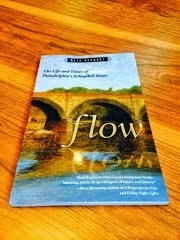 My collaboration with the Fairmount Water Works is long and rich, and today I'm pleased to share the news that that relationship has now been extended through a fantastic new program funded by the William Penn Foundation.
My collaboration with the Fairmount Water Works is long and rich, and today I'm pleased to share the news that that relationship has now been extended through a fantastic new program funded by the William Penn Foundation.The program, designed to "improve environmental education in Philadelphia middle schools and to engage new audiences in art," is fully described below. Flow: The Life and Times of Philadelphia's Schuylkill River, a book I've taught to the children of Project FLOW, will be an integral part of this program—a copy given to each participating student and teacher. I'll also be meeting with the teachers to conduct a writing workshop based on the book.
I am, of course, delighted.
The release about the broad program, as it appears in today's Philly.com:
Fairmount Water Works Receives More Than $500,000 from William Penn Foundation Grants Open Up Opportunities for Watershed Education, Art and Engagement PHILADELPHIA--(BUSINESS WIRE)--A pair of grants from the William Penn Foundation will allow the Fairmount Water Works to improve environmental education in Philadelphia middle schools and engage new audiences through art.
The Foundation awarded the Fairmount Water Works $506,000 to launch a three-year Middle School Teacher Fellowship Program to develop a curriculum that integrates urban watershed education with core science and English standards for sixth through eighth grade students. It also awarded an $82,500 planning grant for the Fairmount Water Works to prototype an interactive and kinetic sculpture near the river and the Water Works’ historic building.
Middle School Fellowship Program
Fifty-four Philadelphia School District teachers will create and test lessons in their classrooms and receive monthly training, classroom support from environmental educators, curriculum specialists and experts from the Philadelphia Water Department, and funds for supplies, staff development and bus transportation for field trips. The program is based on the Fairmount Water Works’ existing program, Understanding the Urban Watershed Curriculum Guide, a framework for lessons on watershed, and water use in the context of an urban environment. More than 1,500 students will be reached in the program’s first three years.
“We’re developing this curriculum at a time when the need for high-quality environmental education is critical so students can understand the issues we face in Philadelphia, and across the United States,” said Karen Young, Director of the Fairmount Water Works. “Our goal is to help teachers increase engagement and academic achievement by integrating real-world environmental experiences, hands-on exploration and project-based learning into the classroom.”
Student teacher volunteers from Temple University’s TU Teach program, University of Pennsylvania’s Graduate School of Education and Bryn Mawr College’s Community Praxis program will also support the teachers.




Published on October 09, 2014 07:47
October 8, 2014
Honored to be included in Whatever Doesn't Kill You: The Shebooks Print Anthology
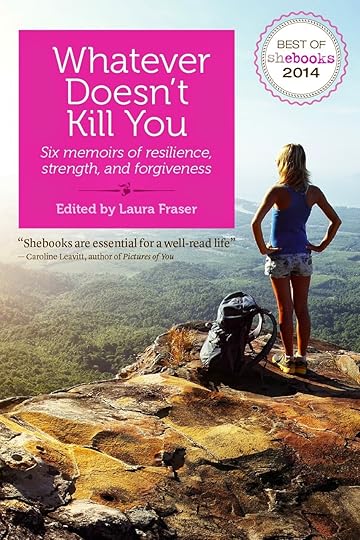
I am deeply honored to have my memoir, Nest. Flight. Sky., selected as one of six memoirs for the first Shebooks print anthology. I stand in glorious good company. I am grateful to Laura Fraser, Peggy Northrop, and the entire Shebooks family, and I cannot wait to hold this book in my hands.
COMING SOON | AVAILABLE FOR PRE-ORDER NOW
Shebooks, a new media company devoted to women’s storytelling, presents its best short memoirs in this print anthology, Whatever Doesn’t Kill You: Six Memoirs of Resilience, Strength, and Forgiveness.
In “Ricochet: Two women war reporters and a friendship under fire,” award-winning journalist Mary Jo McConahay explores the personal toll of war reporting in Central America.
Playwright and author Barbara Graham’s delicate “Camp Paradox: A memoir of stolen innocence” takes on the taboo topic of women abusing younger girls.
Susan Ito’s “The Mouse Room” is the quirky tale of a young woman working in a genetics lab while trying to find her own birth mother.
Faith Adiele’s “ The Nordic-Nigerian Girls’ Guide to Lady Problems” makes a trip to the gynecologist’s office funny, while exposing racial disparities in women’s health care.
Award-winning short story writer Ethel Rohan’s “Out of Dublin” is an exquisite tale of emotional survival.
In the gorgeous “Nest. Flight. Sky.” memoirist Beth Kephart muses on her mother’s death and her new-found obsession with birds.
All these true life stories are brave and beautifully written. The authors use the power of writing to understand and transcend challenges– their memoirs are an inspiration for all of us.
Edited by Laura Fraser.
“Shebooks are essential for a well-read life”-- Caroline Leavitt, author of Pictures of You




Published on October 08, 2014 19:34



